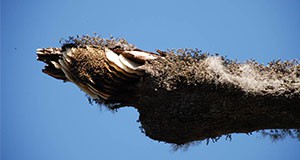African honey bees entered the United States in the early 1990s and have since spread throughout the Southwest and Southeast, including parts of Florida. Compared to European bees, African bees are highly aggressive when disturbed and are more likely to sting humans and animals. This 6-page fact sheet covers the history and distribution of African honey bees in the Americas and explains how beekeepers and residents can manage their interactions with these bees. Written by H. Glenn Hall, Catherine Zettel-Nalen and James D. Ellis, and published by the UF Department of Entomology and Nematology, December 2014. http://edis.ifas.ufl.edu/mg113
Tag: Glenn Hall
Miner Bee, Chimney Bee Anthophora abrupta Say (EENY512/IN912)
 These gregarious, yet solitary, ground-nesting bees are “…conspicuous as they noisily swing their ponderous bodies to and fro on the wing, arrive home and scramble into their burrows or come tumbling out headlong and dash off into the sunny fields, with all the exuberance of boys just out of school.” This 5-page fact sheet was written by Jason R. Graham, Jamie Ellis, Glenn Hall, and Catherine Zettel Nalen, and published by the UF Department of Entomology and Nematology, December 2011.
These gregarious, yet solitary, ground-nesting bees are “…conspicuous as they noisily swing their ponderous bodies to and fro on the wing, arrive home and scramble into their burrows or come tumbling out headlong and dash off into the sunny fields, with all the exuberance of boys just out of school.” This 5-page fact sheet was written by Jason R. Graham, Jamie Ellis, Glenn Hall, and Catherine Zettel Nalen, and published by the UF Department of Entomology and Nematology, December 2011.
http://edis.ifas.ufl.edu/in912
